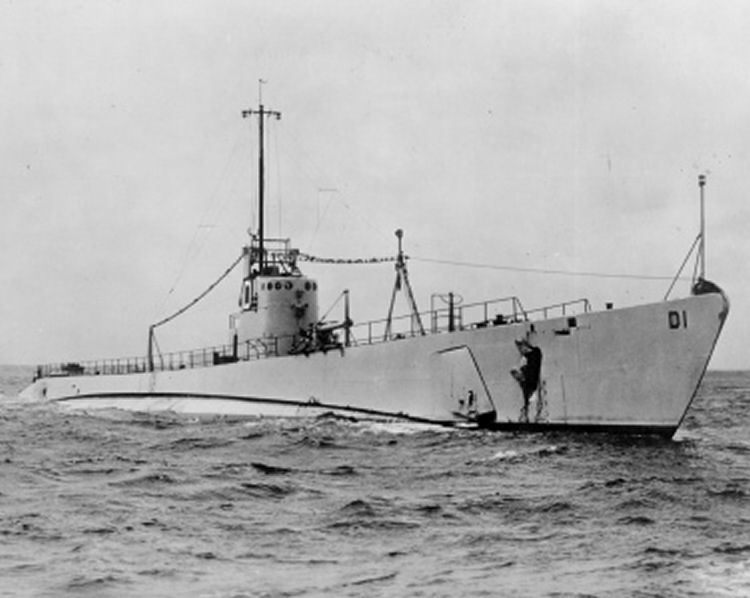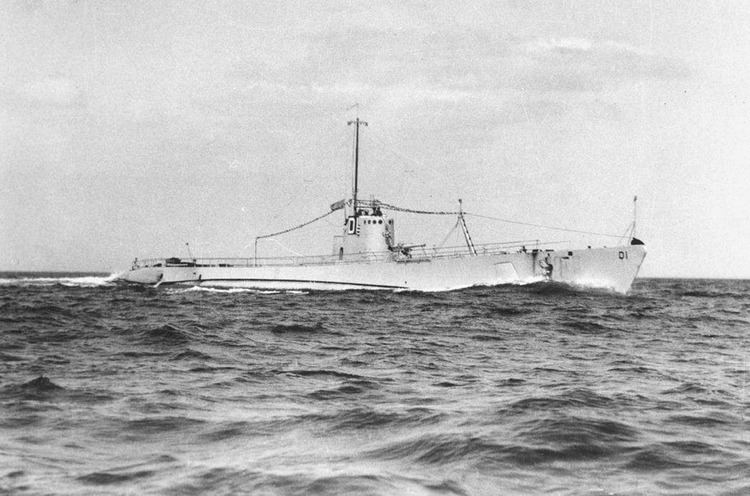Laid down 14 June 1930 Decommissioned 2 October 1945 Construction started 14 June 1930 Length 97 m | Namesake Dolphin Commissioned 1 June 1932 Struck 24 October 1945 Launched 8 March 1932 | |
 | ||
USS Dolphin (SF-10/SC-3/SS-169), a submarine and one of the "V-boats", was the sixth ship of the United States Navy to be named for that aquatic mammal. She also bore the name V-7 and the classifications SF-10 and SC-3 prior to her commissioning. She was launched on 6 March 1932 by the Portsmouth Navy Yard, sponsored by Mrs. E.D. Toland, and commissioned on 1 June 1932 with Lieutenant John B. Griggs, Jr. in command.
Contents

Design

Dolphin was the penultimate design in the V-boat series. With a length of 319 ft (97 m) and a displacement only a little more than half that of the previous three large cruiser submarines (1,718 long tons (1,746 t) surfaced, 2,240 long tons (2,280 t) submerged), Dolphin was clearly an attempt to strike a happy medium between those latter submarines and earlier S-class submarines, which were little more than large coastal boats. The general arrangement of propulsion machinery was identical to that of V-5 and V-6, but even with a surface displacement of only 1,718 tons, Dolphin′s scaled-down main engines—rated at 1,750 hp (1,300 kW) each—could only just deliver the surface speed of the larger ships, and her endurance and torpedo load-out were much reduced. The torpedo armament was six 21 inch (533 mm) tubes (4 bow, 2 stern), with 18 torpedoes. A 4 inch (102 mm)/50 caliber deck gun was equipped. Interestingly, Dolphin's size and weight were nearly ideal for the range and duration of the war patrols that became customary in the Pacific during World War II, and the war-time Gato, Balao, and Tench classes had similar dimensions.

The engine specifications were two BuEng-built, MAN-designed direct-drive 6-cylinder 4-stroke diesel engines, 1,750 hp (1,300 kW) each, with two BuEng MAN 4-cycle 6-cylinder auxiliary diesel engines, 450 hp (340 kW) each, driving 300 kW (400 hp) electrical generators. The auxiliary engines were for charging batteries or for increased surface speed via a diesel-electric system providing power to the main electric motors. Unusually for the V-boats, Dolphin's engines were never replaced.
Inter-war period
Dolphin departed Portsmouth, New Hampshire on 24 October 1932 for San Diego, California, arriving on 3 December to report to Submarine Division 12 (SubDiv 12). She served on the West Coast, taking part in tactical exercises and test torpedo firings until 4 March 1933, when she got underway for the East Coast. She arrived at Portsmouth Navy Yard on 23 March for final trials and acceptance, remaining there until 1 August. Dolphin returned to San Diego on 25 August 1933 to rejoin SubDiv 12.
In 1933, Dolphin tested an unusual feature for submarines of having a motor boat, stored in a waterproof compartment, which could be brought out when needed. At that time, most navies thought that in wartime submarines would be required to board and inspect merchant vessels before they could sink them, as had often been done in World War I, except in periods of unrestricted submarine warfare.
She cruised on the west coast with occasional voyages to Pearl Harbor, Alaska, and the Panama Canal Zone for exercises and fleet problems. On 1 December 1937, Dolphin departed San Diego for her new homeport, Pearl Harbor, arriving one week later. She continued to operate in fleet problems and training exercises, visiting the West Coast on a cruise from 29 September to 25 October 1940. Located at Pearl Harbor on 7 December 1941, Dolphin took the attacking enemy planes under fire, and then left for a patrol in search of Japanese submarines in the Hawaiian Islands.
World War II
Dolphin departed from Pearl Harbor on 24 December 1941 on her first war patrol, during which she reconnoitered in the Marshall Islands in preparation for later air strikes.
She returned to Pearl Harbor on 3 February 1942 to refit and resupply, and then got underway once more on 14 May. Searching a wide area west of Midway Island, she patrolled off the island itself during the pivotal Battle of Midway from 3 to 6 June. She put in to the atoll for repairs from 8 to 11 June, and then she returned to her patrol, attacking a destroyer and a tanker with undetermined results before returning to Pearl Harbor on 24 July.
Her third war patrol, from 12 October to 5 December, was in the storm-tossed waters of the Kurile Islands, where she performed reconnaissance essential to the operations that were to keep Japanese bases there largely ineffective throughout the war.
With newer submarines now available for offensive war patrols, Dolphin was assigned less dramatic but still vital service on training duty at Pearl Harbor until 29 January 1944, when she sailed for exercises in the Canal Zone, and duty as a school boat at Submarine Base New London, Connecticut, where she arrived on 6 March. She served in this essential task until the end of the war, then was decommissioned on 12 October 1945 at the Portsmouth Navy Yard.
Dolphin was sold for scrap on 26 August 1946.
